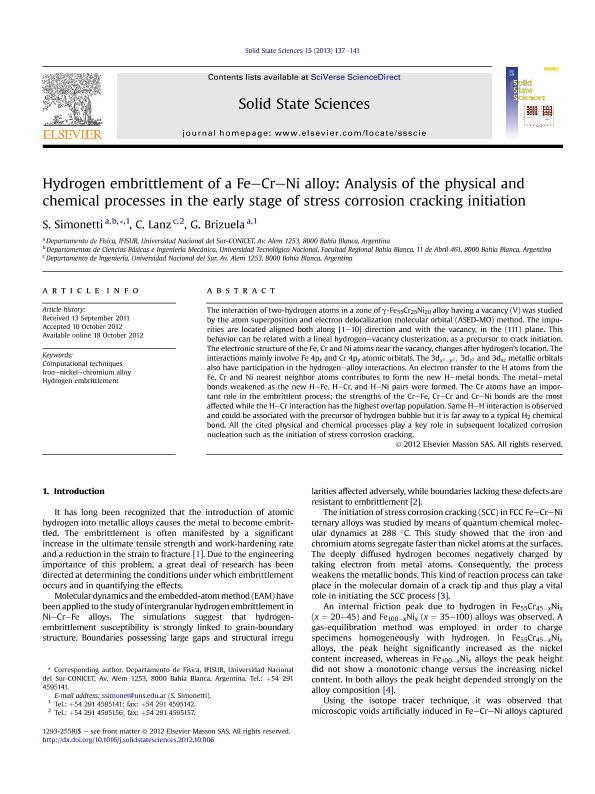Mostrar el registro sencillo del ítem
dc.contributor.author
Simonetti, Sandra Isabel

dc.contributor.author
Lanz, César Armando

dc.contributor.author
Brizuela, Graciela Petra

dc.date.available
2015-09-23T18:04:17Z
dc.date.issued
2013-01
dc.identifier.citation
Simonetti, Sandra Isabel; Lanz, César Armando; Brizuela, Graciela Petra; Hydrogen embrittlement of a Fe-Cr-Ni alloy: Analysis of the physical and chemical processes in the early stage of stress corrosion cracking initiation; Elsevier; Solid State Sciences; 15; 1-2013; 137-141
dc.identifier.issn
1293-2558
dc.identifier.uri
http://hdl.handle.net/11336/2065
dc.description.abstract
The interaction of two-hydrogen atoms in a zone of g-Fe55Cr25Ni20 alloy having a vacancy (V) was studied by the atom superposition and electron delocalization molecular orbital (ASED-MO) method. The impurities are located aligned both along [1e10] direction and with the vacancy, in the (111) plane. This behavior can be related with a lineal hydrogenevacancy clusterization, as a precursor to crack initiation. The electronic structure of the Fe, Cr and Ni atoms near the vacancy, changes after hydrogen’s location. The interactions mainly involve Fe 4px and Cr 4py atomic orbitals. The 3dx2 y2 ; 3dz2 and 3dxz metallic orbitals also have participation in the hydrogenealloy interactions. An electron transfer to the H atoms from the Fe, Cr and Ni nearest neighbor atoms contributes to form the new Hemetal bonds. The metalemetal bonds weakened as the new HeFe, HeCr, and HeNi pairs were formed. The Cr atoms have an important role in the embrittlent process; the strengths of the CreFe, CreCr and CreNi bonds are the most affected while the HeCr interaction has the highest overlap population. Same HeH interaction is observed and could be associated with the precursor of hydrogen bubble but it is far away to a typical H2 chemical bond. All the cited physical and chemical processes play a key role in subsequent localized corrosion nucleation such as the initiation of stress corrosion cracking.
dc.format
application/pdf
dc.language.iso
eng
dc.publisher
Elsevier

dc.rights
info:eu-repo/semantics/openAccess
dc.rights.uri
https://creativecommons.org/licenses/by-nc-nd/2.5/ar/
dc.subject
COMPUTATIONAL TECHNIQUES
dc.subject
HYDROGEN EMBRITTLEMENT
dc.subject
IRON-NICKEL-CHROMIUM ALLOY
dc.subject.classification
Ingeniería de los Materiales

dc.subject.classification
Ingeniería de los Materiales

dc.subject.classification
INGENIERÍAS Y TECNOLOGÍAS

dc.title
Hydrogen embrittlement of a Fe-Cr-Ni alloy: Analysis of the physical and chemical processes in the early stage of stress corrosion cracking initiation
dc.type
info:eu-repo/semantics/article
dc.type
info:ar-repo/semantics/artículo
dc.type
info:eu-repo/semantics/publishedVersion
dc.date.updated
2016-03-30 10:35:44.97925-03
dc.journal.volume
15
dc.journal.pagination
137-141
dc.journal.pais
Francia

dc.journal.ciudad
París
dc.description.fil
Fil: Simonetti, Sandra Isabel. Consejo Nacional de Investigaciones Científicas y Técnicas. Centro Científico Tecnológico - CONICET - Bahía Blanca. Instituto de Física del Sur; Argentina. Universidad Tecnológica Nacional. Facultad Regional Bahía Blanca; Argentina
dc.description.fil
Fil: Lanz, César Armando. Universidad Nacional del Sur. Departamento de Ingeniería; Argentina
dc.description.fil
Fil: Brizuela, Graciela Petra. Consejo Nacional de Investigaciones Científicas y Técnicas. Centro Científico Tecnológico - CONICET - Bahía Blanca. Instituto de Física del Sur; Argentina
dc.journal.title
Solid State Sciences

dc.relation.alternativeid
info:eu-repo/semantics/altIdentifier/url/http://www.sciencedirect.com/science/article/pii/S1293255812003202
dc.relation.alternativeid
info:eu-repo/semantics/altIdentifier/doi/http://dx.doi.org/10.1016/j.solidstatesciences.2012.10.006
Archivos asociados
